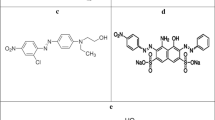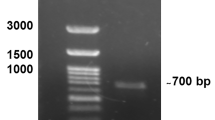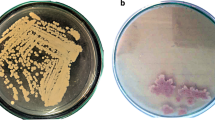Abstract
The response surface methodology was used for the optimization of different submerged fermentation conditions for the production of recombinant laccase Lcc1 in Pichia pastoris KM71H. The initial screening of production parameters was performed using a Plackett–Burman design, and the variables with significant effects on laccase production were identified as follows: medium initial pH, methanol additive amount and liquid volume. These variables were selected for further optimization studies using a Box-Behnken design. The results indicated that the optimum fermentation conditions were as follows: medium optimal initial pH value of 7.01, methanol additive amount of 0.63% (v/v) per 24 h and liquid volume of 19.50% (v/v). These conditions provided the highest laccase enzyme activity of 12,491 U/L, resulting in a 3-fold increase in the production of recombinant laccase. Using industrial basic salt as culture medium, the maximum enzyme activity of Lcc1 was 22,594 U/L after high-density fermentation, which was 1.8-fold increase by shake flask optimization. Furthermore, partially purified laccase was used for the degradation of the octyl phenol and 4-tert-octylphenol, which displayed excellent degradation capacity. After 24 h, the degradation rate of 200 mg/L of 4-tert-octylphenol at 40 °C, pH 4.5 using 50 mM tartaric acid buffer with 1500 U/L purified laccase enzyme in L/A (laccase/ABTS) system was 97.2%. For octyl phenol, the degradation rate was 93.1%. All of the results suggested that the laccase Lcc1 significantly reduced or eliminated the toxicity of octyl phenol and 4-tert-octylphenol, which may be suitable for typical phenolic pollutants in the environment.
Graphical Abstract








Similar content being viewed by others
References
Yang X, Wu Y, Zhang Y et al (2020) Front Microbiol 11:241
Liu M, Dong H, Wang M et al (2020) J Genet 99:23
Zhang CY, You SP, Liu YD et al (2020) Biores. Technol. 305:123085
Zhou WT, Zhang WX, Cai YP (2020) Chem. Eng. J. 403:126272
Jiang YP, Cai JL, Pei JJ et al (2021). ACS Omega. https://doi.org/10.1021/acsomega.1c00370
Christopher LP, Yao B, Ji Y (2014). Front Energ Res. https://doi.org/10.3389/fenrg.2014.00012
Aracri E, Fillat A, Colom JF et al (2010) Biores Technol 101:8211–8216
Aza P, Salas FD, Molpeceres G et al (2021) Int J Mol Sci 22:1157
Li Q, Pei JJ, Zhao LG et al (2014) Appl Biochem Microbiol 50:140–147
Bezerra MA, Santelli RE, Oliveira EP et al (2008) Talanta 76:965–977
Amin M, Bhatti HN, Sadaf S, et al (2021) Cataly Lett 2
Bartley ML, Boeing WJ, Daniel D et al (2016) J Appl Phycol 28:15–24
Unuofin JO, Okoh AI, Nwodo UU (2019) J Environ Manage 231:222–231
Jegatheesan M, Eyini M (2015) Arab J Sci Eng 40:1809–1818
Diwaniyan S, Sharma KK, Kuhad RC (2012) J Basic Microbiol 52:397–407
Knapczyk-Stwora K, Nynca A, Ciereszko RE et al (2020) Theriogenology 153:102–111
Ffwa B, Yan Z, Xyza B et al (2020) J Chromatography A 1635:461765
Jeannot R, Sabik H, Sauvard E et al (2002) J Chromatogr A 974:143–159
Tsuda T, Takino A, Kojima M et al (1999) J Chromatography B 723:273–279
Zhang KW, Sai YE, Guang-Shui NA et al (2008) Chin J Analysis Lab 27:62–66
Wang H, Deng W, Shen M et al (2020) J Hazardous Mater 408:124775
Maryskova M, Linhartova L, Novotny V et al (2021). Environ Sci Pollut Research. https://doi.org/10.1007/s11356-021-12910-0
Li Q, Zhao DX, Liu SP et al (2014) J Nanjing Forestry Univ (Nat Sci Edtn) 38(3):93–97
Childs RE, Bardsley WG (1975) Biochem J 145:93–103
Bradford MM (1976) Anal Biochem 72:248–254
Burman JP, Plackett RL (1946) Biometals 33:305–325
Box G, Behnken DW (1960) Technometrics 2:455–475
Kececioglu D, Lamarre G (1978) Nucl Eng Des 50:149–162
El-Naggar EA (2019).
Kumari A, Mahapatra P, Banerjee R (2009) Braz Arch Biol Technol 52:1349–1356
Xia J, Wang Q, Luo Q et al (2019) Process Biochem 78:33–41
Vicente AI, Via-Gonzalez J, Santos-Moriano P et al (2016) J Mol Catal B Enzymatic 134:323–330
Yasmina M, Zhou S, Cusano AM et al (2014) J Biosci Bioeng 117(1):25–27
Danilo R, Chiara CM, Maurizio R et al (2010) FEMS Yeast Res 6:892–902
Bailey MJ, Adamitsch B, Rautio J et al (2007) Enzyme Microb Technol 41:484–491
Liang X, Hua DL, Zhao YX et al (2020) BioResources 15:9
Xie HF, Li Q, Wang MM et al (2013) J Microbiol Biotechnol 23(6):864–871
Hilgers RJ, Vincken JP, Gruppen H et al (2018) Acs Sust Chem Eng 6:2037–2046
D ‘Acunzo F, Galli C, Masci B (2010) Febs J 269:5330–5335
Wells A, Teria M, Eve T (2006) Biochem Soc Trans 34:304–308
Habimana P, Gao J, Mwizerwa JP et al (2021). ACS Omega. https://doi.org/10.1021/acsomega.0c05081
Zhao J, Zeng SQ, Xia Y et al (2018) J Biosci Bioeng 125(4):371–376
Xia TT, Feng M, Liu CL, et al. Eng Life Sci 1–8 (2021).
Qiu X, Wang Y, Xue Y et al (2019) Chem Eng J 391:123564
Gu Y, Xue P, Shi K (2020) J Porous Mater 27:73–82
Acknowledgements
This work was supported by the International Advanced Forestry Science and Technology Project Imported by State Forestry Administration (Grant No. 2011-4-15, 2010-4-19).
Author information
Authors and Affiliations
Contributions
Author contributions were as follows: Qi Li, Changsheng Chai, and Linguo Zhao conceived and designed the experiments; Qi Li performed all the experiments and analyzed the data; Yitong Du and Junli Cai helped to perform the experiments; Qi Li wrote the paper. All authors have read and approved the manuscript.
Corresponding author
Ethics declarations
Conflict of Interest
The authors declare no conflicts of interest.
Additional information
Publisher's Note
Springer Nature remains neutral with regard to jurisdictional claims in published maps and institutional affiliations.
Rights and permissions
About this article
Cite this article
Li, Q., Chai, C., Du, Y. et al. Recombinant Laccase Production Optimization in Pichia pastoris by Response Surface Methodology and Its Application in the Biodegradation of Octyl Phenol and 4-Tert-Octylphenol. Catal Lett 152, 1086–1099 (2022). https://doi.org/10.1007/s10562-021-03682-w
Received:
Accepted:
Published:
Issue Date:
DOI: https://doi.org/10.1007/s10562-021-03682-w




